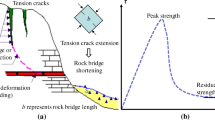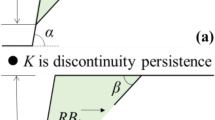Abstract
Rock bridges have been the subject of considerable research since the 1970’s with a focus on developing methods to measure rock bridges and quantifying their role with respect to rock mass strength. In the literature, rock bridges are generally defined as a portion of intact rock separating discontinuity surfaces; however, whether a portion of intact rock resists failure and, therefore, represents a critical rock bridge depends on the failure mechanisms that may develop within the rock mass. The difficulty of defining what constitutes a rock bridge is associated with the challenge of measuring rock bridges in the field. This aspect is often ignored by engineers and practitioners, who fail to recognise that rock bridges could exist even within a rock mass characterised by fully continuous surfaces. Furthermore, field evidence of rock slope failure shows that rock bridges do not fail at the same time, and a simple definition of a rock bridge as the distance between existing discontinuities cannot account for progressive rock mass damage and changes in stresses within a rock mass. The authors suggest that the concept itself of rock bridges may be flawed, and more attention should be given to better understanding damage-related processes, including time-dependent damage in the context of engineered structures.

(Modified from Elmo et al. 2018)

(Modified from Elmo et al. 2018)





(Adapted from Elmo et al. 2018)













Similar content being viewed by others
References
Alghalandis YF, Elmo D (2018) Application of graph theory for robust and efficient rock bridge analysis. In: 2nd International discrete fracture network engineering conference, Seattle, WA, USA, 20–22 June 2018. Paper 733
Alghalandis YF, Dowd PA, Xu C (2015) Connectivity field: a measure for characterising fracture networks. Math Geosci 47(1):63–83
Alzo’ubi A (2009) The effect of tensile strength on the stability of rock slopes. PhD thesis, Department of Civil and Environmental Engineering, University of Alberta, Edmonton, Alberta, Canada
Arikan F, Ulusay R, Aydın N (2007) Characterisation of weathered acidic volcanic rocks and a weathering classification based on a rating system. Bull Eng Geol Environ 66(4):415–430
Baczynski NRP (2000) Stepsim4 - “Step-path” method for slope risks. In: Proc., GeoEng Int. Conf. Geotech. Geol. Eng., Melbourne, p 6
Baczynski NRP (2008) STEPSIM4 revised: network analysis methodology for critical paths in rock mass slopes. In: Proceedings of the 2008 southern hemisphere international rock mechanics symposium, September 16–19, Perth, pp 405–418
Call RD, Nicholas DE (1978) Prediction of step path failure geometry for slope stability analysis. In: Proc. of the 19th US symposium on rock mechanics, Stateline, Nevada; Int J Rock Mech Min Sci Geomech. Abst, vol 16, p 8
Dershowitz WS, Finnila A, Rogers S, Hamdi P, Moffitt KM (2017) Step path rock bridge percentage for analysis of slope stability. In: Proc. of 51st U.S. rock mechanics/geomechanics symposium, San Francisco, CA, USA. Paper 1045
Einstein HH, Veneziano D, Baecher GB, O’Reilly KJ (1983) The effect of discontinuity persistence on rock slope stability. Int J Rock Mech Min Sci Geomech 20:227–236
Elmo D (2006) Evaluation of a hybrid FEM/DEM approach for determination of rock mass strength using a combination of discontinuity mapping and fracture mechanics modelling, with emphasis on modelling of jointed pillars. Ph.D. thesis, Camborne School of Mines, University of Exeter, UK
Elmo D, Stead D (2010) An integrated numerical modelling - discrete fracture network approach applied to the characterisation of rock mass strength of naturally fractured pillars. Rock Mech Rock Eng 43(1):3–19
Elmo D, Rogers S, Stead D, Eberhardt, E (2014) A Discrete fracture network approach to characterise rock mass fragmentation and implications for geomechanical upscaling. Min Technol J 123(3):149–161
Elmo D, Stead D (2016) Applications of fracture mechanics to rock slopes. Invited chapter, rock mechanics and engineering volume 3: analysis, modeling & design, chapter 23, p 34
Elmo D, Stead D (2020) Disrupting rock engineering concepts: is there such a thing as a rock mass digital twin and are machines capable of “learning” rock mechanics. In: Int. symposium on open pit mining and civil engineering, Perth
Elmo D, Moffitt K, D’Ambra S, Stead D (2009) A quantitative characterisation of brittle rock fracture mechanisms in rock slope failures. In: Proceedings of: int. symposium on rock slope stability in open pit mining and civil engineering, Santiago, Chile
Elmo D, Moffitt K, Carvalho J (2016) Synthetic rock mass modelling: experience gained, and lessons learned. In: 50th U.S. rock mechanics symposium, Houston, TX, June 2016. Paper 777
Elmo D, Donati D, Stead D (2018) Challenges in the characterisation of rock bridges. Eng Geol 245:81–96
Elmo D, Stead D, Yang B (2020a) Disrupting the concept of rock bridges. In: Proc. 52nd int. symposium on rock mechanics, Golden, CO, June 2020. Paper 2063
Elmo D, Yang B, Stead D, Rogers S (2020b) A new discrete fracture network approach to rock mass classification. In: Proceedings of the 16th international conference on computer methods and advances in geomechanics, Turin, Italy, July 2020
Guerin A, Jaboyedoff M, Collins BD (2019) Detection of rock bridges by infrared thermal imaging and modeling. Sci Rep 9:13138. https://doi.org/10.1038/s41598-019-49336-1
Hencher SR, Lee SG, Carter TG, Richards LR (2012) Sheet joints: characterisation, shear strength and engineering. Rock Mech Rock Eng 44:1–22
Hoek E, Brown ET (1980) Underground excavations in rock. Institution of mining and metallurgy, London, p 527
Hoek E, Kaiser PK, Bawden WF (1995) Support of underground excavations in hard rock. Balkema, Rotterdam
ISRM (1981) International society of rock mechanics suggested methods for rock characterisation testing and monitoring. Brown ET (ed) Imprint Oxford, Pergamon, p 211
Jennings JE (1970) A mathematical theory for the calculation of the stability of slopes in open cast mines. In: Van Rensburg (ed) Planning open pit mines, Proceedings, Johannesburg. A.A. Balkema, Cape Town, pp 87–102
Kaiser P (2019) 8th Mueller lecture presented at the 14th ISRM Congress, Brazil, CRC Press, pp 141–182
Kemeny J (2005) Time-dependent drift degradation due to the progressive failure of rock bridges along discontinuities. Int J Rock Mech Min Sci 42(1):35–45
Martin CD, Christiansson R, Soederhaell J (2001) Rock stability considerations for siting and constructing a KBS-3 repository, SKB technical report TR-01-38. https://inis.iaea.org/collection/NCLCollectionStore/_Public/33/004/33004840.pdf?r=1
Munjiza A, Owen DRJ, Bicanic N (1995) A combined finite-discrete element method in transient dynamics of fracturing solids. Eng Comput 12:145–174
Owen DRJ, Feng YT, de Souza Neto EA, Cottrell MG, Wang F, Andrade Pires FM, Yu J (2004) The modeling of multifracturing solids and particulate media. Int J Numer Methods Eng 60(1):317–339
Pierce M, Cundall P, Potyondy P, Mas Ivars D (2007) A synthetic rock mass model for jointed rock. In: Proc. 1st Canada-US rock mechanics symposium. Vancouver, vol 1, pp 341–349
Read JR, Lye GN (1984) Pit slope design methods: Bougainville copper open cut. In: Proceedings, 5th international congress on rock mechanics, Melbourne, pp C93–C98
Rockfield (2019) Rockfield Software Ltd. Swansea. UK. Elfen version 5.7.1. http://www.rockfield.co.uk
Romer C, Ferentinou M (2019) Numerical investigations of rock bridge effect on open pit slope stability. J Rock Mech Geotech Eng 11(6):1184–1200
Sampaleanu C (2017) The role of intact rock fracture in rockfall initiation. M.Sc. thesis, Simon Fraser University, Vancouver, Canada
Sampaleanu C, Stead D, Schlotfeldt P (2017) Evaluating rockfall hazard on Stawamus Chief, Squamish, British Columbia. In: Proc. CGS Conf., GeoOttawa, p 8
Schellenberg S (2016) Phenomenal evidence and factive evidence. Philos Stud 173:875–896
Shang J, Hencher SR, West LJ, Handley K (2017) Forensic excavation of rock masses: a technique to investigate discontinuity persistence. Rock Mech Rock Eng 50:2911–2928
Spreafico M, Franci F, Bitelli G, Borgatti L, Ghirotti M (2017) Intact rock bridge breakage and rock mass fragmentation upon failure: quantification using remote sensing techniques. Photogramm Rec 32(160):513–536
Stacey P, Read J (2009) Guidelines for open pit slope design, 1st edn. CRC Press
Terzaghi K (1962) Stability of steep slopes on hard unweathered rock. Géotechnique 12:251–270
Wang R, Elmo D, Stead D, Rogers S (2017) Characterisation of rock mass representative elementary volume using RQD and a discrete fracture network approach. In: Proceedings of the 51st int. symp. rock mech., San Francisco, U.S. June 2017. Paper 760
Xu C, Dowd PA, Fowell RJ (2006) A connectivity index for discrete fracture networks. Math Geol 38(5):611–634
Acknowledgements
A shorter version of this paper was originally prepared for presentation at the 54th US Rock Mechanics/Geomechanics Symposium (Golden, Colorado, USA, 28 June–1 July 2020) and it was later selected for publication in a special issue of Rock Mechanics and Rock Engineering. In accordance with the editor’s requests, the original manuscript has been extensively revised and significantly extended before consideration by Rock Mechanics and Rock Engineering.
Author information
Authors and Affiliations
Corresponding author
Additional information
Publisher's Note
Springer Nature remains neutral with regard to jurisdictional claims in published maps and institutional affiliations.
Rights and permissions
About this article
Cite this article
Elmo, D., Stead, D., Yang, B. et al. A New Approach to Characterise the Impact of Rock Bridges in Stability Analysis. Rock Mech Rock Eng 55, 2551–2569 (2022). https://doi.org/10.1007/s00603-021-02488-x
Received:
Accepted:
Published:
Issue Date:
DOI: https://doi.org/10.1007/s00603-021-02488-x




